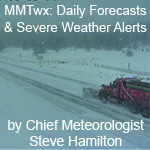- Posts: 3724
- Thank you received: 130
- Forum
- Life Up the Hill
- Scanner & Emergency Info, Weather Forecasts
- wxgeek's weather-North American Monsoon-Update 7/9
wxgeek's weather-North American Monsoon-Update 7/9
- RenegadeCJ
-
 Topic Author
Topic Author
- Mountain Legend
-

Less
More
06 Jul 2014 07:47 - 10 Jul 2014 06:16 #1
by RenegadeCJ
Too bad future generations aren't here to see all the great things we are spending their $$ on!!
wxgeek's weather-North American Monsoon-Update 7/9 was created by RenegadeCJ
Update Wed Jul 9
Monsoon flow in full swing across much of the western U.S. Upper ridge still centered near Moab UT today, so flow around upper High creating northwest flow aloft over CO, so storm motion today from the northwest at 5-10 mph. Thunderstorms in progress across the state this afternoon with some approaching severe limits. As storm motion is rather slow, flash flooding will be a concern today through the weekend as atmosphere has a good amount of moisture to work with. Storms should die down after sunset today with a few lingering until midnight mostly east of I-25.
Upper High is forecast to slide southeast the next couple of days into northern NM, which will create an even better monsoon flow for CO, so expect more numerous storms and heavier precip potential Thursday through Saturday. Activity should be less from Sunday into early next week with the more normal daily monsoon activity, then somewhat drier late next week as upper ridge moves back over CO. Then the following week looks to have better monsoon activity as upper High moves farther east. Temps will likely remain above average for the next 3-10 days as upper ridge remains near CO. Basically, during monsoon season, we get more precip and storms when the upper ridge is to our east, and less activity when it is over us or to our west.
This is our typical monsoon pattern, ebbs and flows in our daily to weekly activity based on where the upper level High resides, so wetter periods and drier periods from now through early to mid September. In general, the southwest mountains tend to get the most precip statewide during our monsoon season, while eastern CO tends to get the least precip. Mountains and foothills average 2-4 inches of rain per month during monsoon season, which lowers our fire danger during this period. It also turns the Desert Southwest into a sauna instead of a dry roast oven
_________________
"Climatology is what you expect, Weather is what you get".
"It is better to be roughly right than precisely wrong".
- Update Mon Jul 7
Monsoon moisture in full swing across portions of AZ, NV and even into central CA, which is a bit unusual. For CO, another hot day across much of the state with readings already near the century mark at Noon. A cold front to our north is forecast to swing south into northeast CO later this evening. Prior to that, isolated showers and thunderstorms already getting kicked off across the mountains, foothills and into adjacent plains from strong surface heating and residual low level moisture. As cold front moves into eastern CO later today, storms expected to develop along front, with some possibly severe. Cooler air will move in behind front, which will keep temps below seasonal averages east of the Divide on Tuesday. Upslope flow will prevail post cold front, which may generate some stratus on the plains and fog into the foothills tonight into early Tuesday below about 8000-9000 ft. Storms could persist into overnight hours tonight associated with activity along cold front.
For Tuesday, slightly cooler air mass in place, but good low level moisture. This will combine with better monsoon flow from the south to produce widespread showers and thunderstorms across most of the state. Highest precip amounts expected over the mountains into the foothills on Tuesday, although activity also expected to make it's way onto the plains.
By Wednesday, temps warm under the influence of strong upper ridge that remains centered in eastern UT, and monsoon moisture will continue up from the south to produce another day of scattered afternoon and evening showers and thunderstorms statewide. This pattern will persist the remainder of the week and into the weekend. Models indicate upper ridge will remain anchored over the central Rockies through the weekend, with monsoon moisture providing afternoon and evening showers and thunderstorms.
For next week, models keep upper ridge in our vicinity, so temps likely to remain at or above seasonal norms, and monsoon moisture will provide daily shower and thunderstorm activity with best chances over the mountains into the foothills.
Meanwhile, in the western Pacific, super typhoon Neoguri is located south of Okinawa with sustained winds to 155 mph. Neoguri is forecast to track northward and intensity into a Category 5 storm with sustained winds to 170 mph as it approaches southern Japan on Wednesday. The typhoon may weaken a bit before landfall, but significant damage is likely across much of southern Japan. Neoguri is then forecast to move into the Sea of Japan along central Japan still as a cateogry 1 typhoon before moving into Hokkaido as a strong tropical storm. Anyone planning travel to Japan should be aware of travel impacts across the country and damage impacts to southern Japan.
_________________
"Climatology is what you expect, Weather is what you get".
"It is better to be roughly right than precisely wrong".
By Monday, low level moisture associated with the Monsoon will begin to work north into CO, so better precip chances will come back into CO most of next week. Upper ridge will remain in eastern UT, so temps will remain above seasonal norms most of next week, but with more clouds and some precip, temps will only be a few degrees above seasonal norms. Next week will feature a fairly typical July pattern with afternoon and evening showers developing over the mountains and drifting into the foothills and adjacent plains. Upper flow will be from the northwest most of next week with storm motion at 5-15 mph.
Longer range models suggest upper ridge will build into the central U.S. the following week which would enhance the monsoon flow. July and August tend to be the wettest months of the year in the mountains and foothills, which reduces fire danger. The Urban Corridor and plains tend to get less precip during the monsoon season as the mountains and foothills wring out most of the moisture. The plains need a lifting mechanism like a front to produce big thunderstorms, while the mountains and foothills use terrain and heating to lift the air and provide precipitation. The latest seasonal outlook from the Climate Prediction Center calls for above average precip for CO from the foothills west for the July - September period.
_________________
"Climatology is what you expect, Weather is what you get".
"It is better to be roughly right than precisely wrong".
Monsoon flow in full swing across much of the western U.S. Upper ridge still centered near Moab UT today, so flow around upper High creating northwest flow aloft over CO, so storm motion today from the northwest at 5-10 mph. Thunderstorms in progress across the state this afternoon with some approaching severe limits. As storm motion is rather slow, flash flooding will be a concern today through the weekend as atmosphere has a good amount of moisture to work with. Storms should die down after sunset today with a few lingering until midnight mostly east of I-25.
Upper High is forecast to slide southeast the next couple of days into northern NM, which will create an even better monsoon flow for CO, so expect more numerous storms and heavier precip potential Thursday through Saturday. Activity should be less from Sunday into early next week with the more normal daily monsoon activity, then somewhat drier late next week as upper ridge moves back over CO. Then the following week looks to have better monsoon activity as upper High moves farther east. Temps will likely remain above average for the next 3-10 days as upper ridge remains near CO. Basically, during monsoon season, we get more precip and storms when the upper ridge is to our east, and less activity when it is over us or to our west.
This is our typical monsoon pattern, ebbs and flows in our daily to weekly activity based on where the upper level High resides, so wetter periods and drier periods from now through early to mid September. In general, the southwest mountains tend to get the most precip statewide during our monsoon season, while eastern CO tends to get the least precip. Mountains and foothills average 2-4 inches of rain per month during monsoon season, which lowers our fire danger during this period. It also turns the Desert Southwest into a sauna instead of a dry roast oven
_________________
"Climatology is what you expect, Weather is what you get".
"It is better to be roughly right than precisely wrong".
- Update Mon Jul 7
Monsoon moisture in full swing across portions of AZ, NV and even into central CA, which is a bit unusual. For CO, another hot day across much of the state with readings already near the century mark at Noon. A cold front to our north is forecast to swing south into northeast CO later this evening. Prior to that, isolated showers and thunderstorms already getting kicked off across the mountains, foothills and into adjacent plains from strong surface heating and residual low level moisture. As cold front moves into eastern CO later today, storms expected to develop along front, with some possibly severe. Cooler air will move in behind front, which will keep temps below seasonal averages east of the Divide on Tuesday. Upslope flow will prevail post cold front, which may generate some stratus on the plains and fog into the foothills tonight into early Tuesday below about 8000-9000 ft. Storms could persist into overnight hours tonight associated with activity along cold front.
For Tuesday, slightly cooler air mass in place, but good low level moisture. This will combine with better monsoon flow from the south to produce widespread showers and thunderstorms across most of the state. Highest precip amounts expected over the mountains into the foothills on Tuesday, although activity also expected to make it's way onto the plains.
By Wednesday, temps warm under the influence of strong upper ridge that remains centered in eastern UT, and monsoon moisture will continue up from the south to produce another day of scattered afternoon and evening showers and thunderstorms statewide. This pattern will persist the remainder of the week and into the weekend. Models indicate upper ridge will remain anchored over the central Rockies through the weekend, with monsoon moisture providing afternoon and evening showers and thunderstorms.
For next week, models keep upper ridge in our vicinity, so temps likely to remain at or above seasonal norms, and monsoon moisture will provide daily shower and thunderstorm activity with best chances over the mountains into the foothills.
Meanwhile, in the western Pacific, super typhoon Neoguri is located south of Okinawa with sustained winds to 155 mph. Neoguri is forecast to track northward and intensity into a Category 5 storm with sustained winds to 170 mph as it approaches southern Japan on Wednesday. The typhoon may weaken a bit before landfall, but significant damage is likely across much of southern Japan. Neoguri is then forecast to move into the Sea of Japan along central Japan still as a cateogry 1 typhoon before moving into Hokkaido as a strong tropical storm. Anyone planning travel to Japan should be aware of travel impacts across the country and damage impacts to southern Japan.
_________________
"Climatology is what you expect, Weather is what you get".
"It is better to be roughly right than precisely wrong".
By Monday, low level moisture associated with the Monsoon will begin to work north into CO, so better precip chances will come back into CO most of next week. Upper ridge will remain in eastern UT, so temps will remain above seasonal norms most of next week, but with more clouds and some precip, temps will only be a few degrees above seasonal norms. Next week will feature a fairly typical July pattern with afternoon and evening showers developing over the mountains and drifting into the foothills and adjacent plains. Upper flow will be from the northwest most of next week with storm motion at 5-15 mph.
Longer range models suggest upper ridge will build into the central U.S. the following week which would enhance the monsoon flow. July and August tend to be the wettest months of the year in the mountains and foothills, which reduces fire danger. The Urban Corridor and plains tend to get less precip during the monsoon season as the mountains and foothills wring out most of the moisture. The plains need a lifting mechanism like a front to produce big thunderstorms, while the mountains and foothills use terrain and heating to lift the air and provide precipitation. The latest seasonal outlook from the Climate Prediction Center calls for above average precip for CO from the foothills west for the July - September period.
_________________
"Climatology is what you expect, Weather is what you get".
"It is better to be roughly right than precisely wrong".
Too bad future generations aren't here to see all the great things we are spending their $$ on!!
Last edit: 10 Jul 2014 06:16 by RenegadeCJ.
The following user(s) said Thank You: Ashley
Please Log in or Create an account to join the conversation.
- HEARTLESS
-

- User is blocked
-

Less
More
- Posts: 4316
- Thank you received: 30
06 Jul 2014 15:02 #2
by HEARTLESS
The silent majority will be silent no more.
Replied by HEARTLESS on topic wxgeek's weather-North American Monsoon-Update 7/9
Any idea when wxgeek will update the Conifer Mountain Weather Almanac?
The silent majority will be silent no more.
Please Log in or Create an account to join the conversation.
- RenegadeCJ
-
 Topic Author
Topic Author
- Mountain Legend
-

Less
More
- Posts: 3724
- Thank you received: 130
07 Jul 2014 08:27 #3
by RenegadeCJ
Too bad future generations aren't here to see all the great things we are spending their $$ on!!
Replied by RenegadeCJ on topic wxgeek's weather-North American Monsoon-Update 7/9
I don't know...I'll ask him!
Too bad future generations aren't here to see all the great things we are spending their $$ on!!
Please Log in or Create an account to join the conversation.
- RenegadeCJ
-
 Topic Author
Topic Author
- Mountain Legend
-

Less
More
- Posts: 3724
- Thank you received: 130
10 Jul 2014 06:17 #4
by RenegadeCJ
Too bad future generations aren't here to see all the great things we are spending their $$ on!!
Replied by RenegadeCJ on topic wxgeek's weather-North American Monsoon-Update 7/9
Bump for 7/9 update
Too bad future generations aren't here to see all the great things we are spending their $$ on!!
Please Log in or Create an account to join the conversation.
- Forum
- Life Up the Hill
- Scanner & Emergency Info, Weather Forecasts
- wxgeek's weather-North American Monsoon-Update 7/9
Time to create page: 0.129 seconds





